This posting continues Piqueteros, the Argentine Government, & the Right to March into Plaza de Mayo.
What should have been an anti-Bush rally in Plaza de Mayo turned into a stubborn, violent standoff between police and piqueteros about the right to march down Avenida de Mayo and into Plaza de Mayo.
The march was scheduled to commence at 5pm from Congreso. I was running late and didn’t leave our apartment in San Telmo until a quarter till five. Thinking that the subway would be quick, I walked over to Constitucion station to find that it was packed with piqueteros on their way to the march. Then I realized that the march was on “Argentina time” and probably would start at least an hour late.
I got off the subte at the Av de Mayo stop on the “C” line to find that the exits from the subway to the street were locked. (Ok, Argentina, didn’t you learn anything about fire safety and locked exits from Cromagnon?! Alright, maybe that’s a little harsh but there’s an appalling lack of fire safety awareness in this city…yet another post). Anyway, there were several of us who had gotten off the subte and wanted to exit onto Av de Mayo. At first the official at the station just shrugged his shoulders and suggested that we get back on the subte and get off at another stop. One man in a business suit said to him, “We’re not piqueteros.” Soon, the official led us up the steps and unlocked the gate.
As I walked down Av de Mayo towards the Congreso, I noticed a large number of people walking in the same direction. The Avenue was closed and a few of the people were piqueteros going to join up with the rest of the marchers who were gathering in front the Congreso. But, most were simply ordinary people getting off from work on a Friday afternoon during rush hour only to find that the “A” subway line which runs underneath Av de Mayo was closed due to the protest. None of these people looked too happy. I have to say that I didn’t see any reason for the city to close the subway line, though I’m sure that the city said that they had to do that for safety reasons.
Once I got to Congreso I could tell by everyone sitting around that the march was at least a good hour away from starting. So, I wandered back down Av de Mayo towards the Plaza. As my previous post discussed, there had been significant controversy over the right of protesters to enter Plaza de Mayo and I was pleased to hear that the marchers were going to be allowed to enter freely.
Yet, as I crossed Av 9 de Julio, I saw a massive police presence gathered at the intersection of Av de Mayo and 9 de Julio. Walking around the police, I saw the riot squads lined up against the wall of a cafe and waiting. Parked half-a-block away was an armored police vehicle with two water cannons mounted on top. I stopped to look at that vehicle, glanced around, and realized that the police again had no intention of letting the marchers proceed to the Plaza.
So, I waited around to see what was going to happen. As the marchers got nearer, the police formed a double line of officers that closed off Av de Mayo. A swarm of photographers and news media started gathering in front of the officers to wait for the marchers. Standing next to me was a TV reporter interviewing a senior police official about whether the marchers would be allowed to enter Plaza de Mayo. The official said, “Yes, they can enter Plaza de Mayo but they cannot march down Av de Mayo. They will need to go down Av 9 de Julio, down Av Belgrano, and enter the Plaza from Av Roca.” The reporter asked again, if the marchers could enter the Plaza and the officer re-confirmed that they could if they took this route.
From the point where the police blocked Av de Mayo, it is only 5 blocks to the Plaza. On the new route ordered by the police, the marchers would have to go an extra 4 blocks, for a total of 9 blocks. Not really a long way, but clearly not the most direct path. I heard that an offical reason for this new route was to prevent traffic problems. What?! The new route obviously would cause more traffic jams than just letting the marchers walk down Av de Mayo.
The police roadblock of Av de Mayo seemed clearly to be a message from the Kirchner government to the piqueteros about who was in charge: the government. There was an incredible display of police force present. Indeed, I would say that the police presence was excessive, much more than I had seen at any other march this year. Of course, the police (I’m sure acting on orders of the government) were clearly intending to be confrontational.
If the march would have been allowed to continue, then it likely would have been peaceful. However, the tension escalated into a couple of pushing matches between police and a few protesters. I lost track of time during all this, but it must have been more than an hour, or an hour and a half, that this standoff continued. Reportedly, eleven police officers were injured tonight. For most of the time, I was standing right next to the police line and I’m not sure how that happened. I suspect that several of the injured officers were hurt by their riot police as the riot squad with their clubs swinging came jumping over the regular police. I did see one photographer who ended up with a bloody face.
The police intensified their presence by bringing a second armored vehicle with water cannons pointing towards the protesters. I took a few minutes to walk around to get a sense of the crowd. The protesters towards the front of the march were, actually, mostly students. When I realized this, I became even more dismayed at the police force. So, I started taking photographs of the students in the march. In the event that the police used water cannons on these students, who were obviously being well-behaved, I wanted to document who that they were peaceful. These students, late teens/early twenties, were there to protest George Bush’s visit to Argentina in November and were not part of the piquetero movement. It would have been a shame if these students had gotten injured by the police.
I do not want to fault the police and the government entirely for tonight’s conflict. The piqueteros share some of the blame. Rather than accepting the police invitation to a confrontation, the marchers easily could have gone along the suggested route of Av 9 de Julio, Belgrano, and Av Roca to Plaza de Mayo. Indeed, it would have resulted in a bigger protest by blocking even more streets and causing more traffic problems. In this scenario, the police would have ended up looking silly for creating even further gridlock than was necessary. Yet, the marchers who appeared to be under the leadership of the piqueteros did not do that. They held their ground in the middle of 9 de Julio. In my opinion, that was a significant miscalculation since the issue was not the right to march down Av de Mayo but instead the right to enter Plaza de Mayo.
Well, actually, the focus of the march was supposed to be anti-Bush but that somehow got lost in the tense standoff. Dubya should thank Kirchner for that. I never suspected that Kirchner, who has hosted Chavez and Castro, was so supportive of the Bush administration. The people of Argentina had a chance to send a message to Washington tonight but they let internal politics get in the way. There was some sarcasm on my part in this paragraph. But, I do think that a lot of people in the march knew that tonight’s protest wasn’t about Bush but was more about piquetero-government relations.
As I was standing around watching this all unfold tonight, I had a chance to think about the piqueteros. I’ve never really been bothered by their roadblocks, but maybe that’s because I don’t drive here. Also, I think that people who are clearly impoverished and on the margins of society have a right to protest and to exercise their political voice.
I am disturbed, however, by the potential for violence on the part of the piqueteros. Why do they need to carry those big sticks unless they plan to engage in violence? As I walked around the crowd of student protesters, I also observed several piqueteros who were arming themselves for a violent encounter with the police. One piquetero was standing behind a group of students. Clinched in his hands was a slingshot, made of thick rubber. He was ready to fight. But, he was no schoolyard bully; he was a grown man in his thirties. On the other side of more students were piqueteros breaking apart the sidewalk, taking chunks of concrete. They were ready to fight the police.
 As the marchers gave up and moved away towards the Obelisc, a couple of piqueteros hung back and flung stones at the police. Indeed, it was remarkable restraint on the part of the police not to pursue and arrest the them. But, the police, with their riot gear and water cannons let the stone throwers walk off into the night.
As the marchers gave up and moved away towards the Obelisc, a couple of piqueteros hung back and flung stones at the police. Indeed, it was remarkable restraint on the part of the police not to pursue and arrest the them. But, the police, with their riot gear and water cannons let the stone throwers walk off into the night.
Kirchner has called for the piqueteros to stop blocking the streets before the government will sit down and negotiate with them. I have less of a problem with piqueteros blocking the streets, but they need to lay down their sticks and stones. Peaceful, non-violent protests have proven to be remarkably successful as a way of galvanizing international attention on social problems and injustices. There’s a perfectly good example here in Argentina with the Madres de Plaza de Mayo.
Up until now the piquetero marches that I’ve seen have been remarkably peaceful. In looking at the crowds of piqueteros it’s obvious that they are mostly good people. Yet, among them, are an angry violent few that are ruining the reputation of the entire movement.
The piquetero leadership needs to re-examine its tactics. Likewise, the Kirchner government shouldn’t act so stubborn and create unnecessary conflicts that lead to violence.

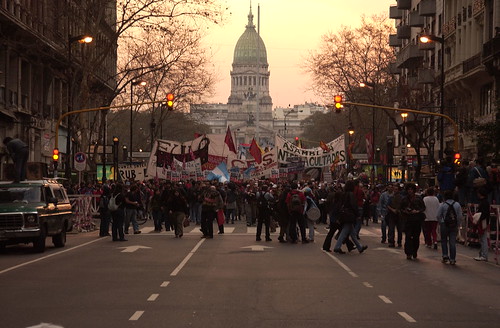


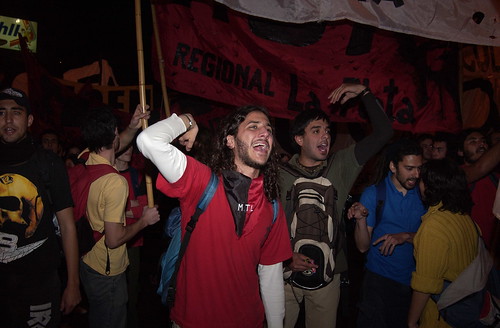
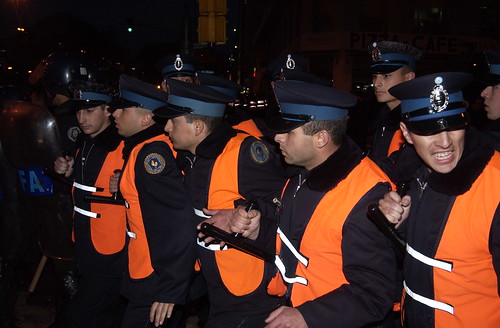
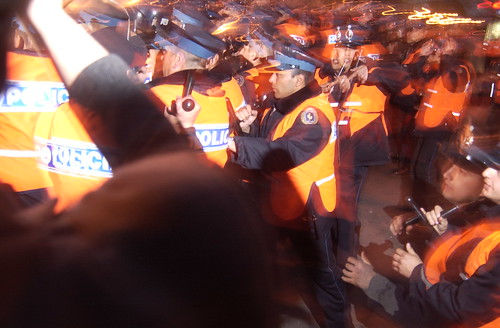

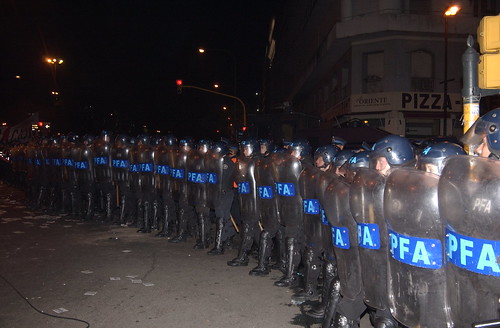

September 17th, 2005 at 4:23 am
[…] Early in the day there was some concern about the march as the government announced the previous night that police would again block parts of Avenida de Mayo and restrict marchers to a specified route in order to reach Plaza de Mayo. Last Friday night’s march became a tense standoff between marchers and the police. It seemed like there was the possibility for more of the same. However, midday Friday, the government changed its mind and announced that marchers would be free to walk all the way down Av de Mayo from Congresso to the Plaza. The opening of Av de Mayo was mediated by Adolfo Pérez Esquivel, who was awarded the Nobel Peace Prize in 1980 for his efforts to promote human rights in Argentina and Latin America. […]
June 3rd, 2013 at 5:11 pm
[…] groups and the police. Last year’s Night of the Pencils march was just one week after a very tense confrontation between piqueteros and police at the intersection of Av de Mayo and Av 9 de Julio. That march was originally planned to be an […]